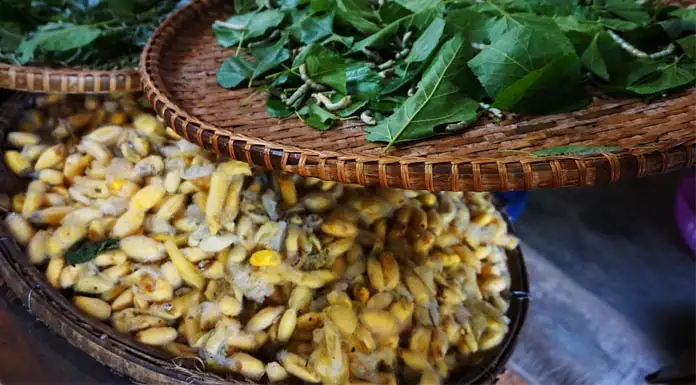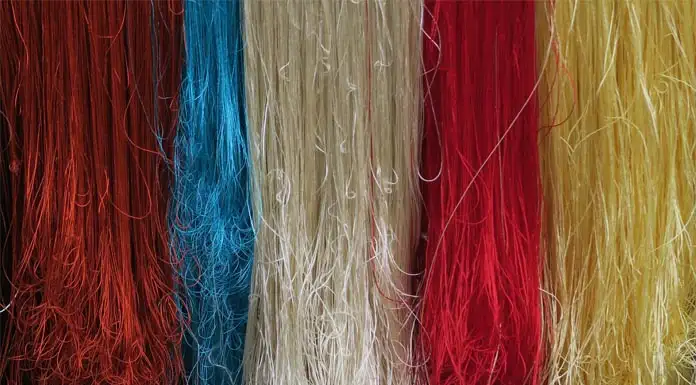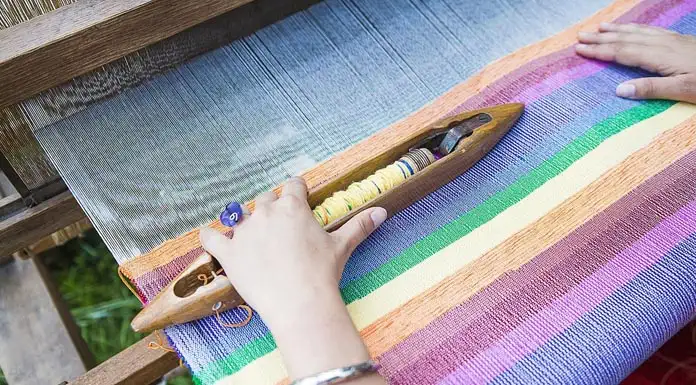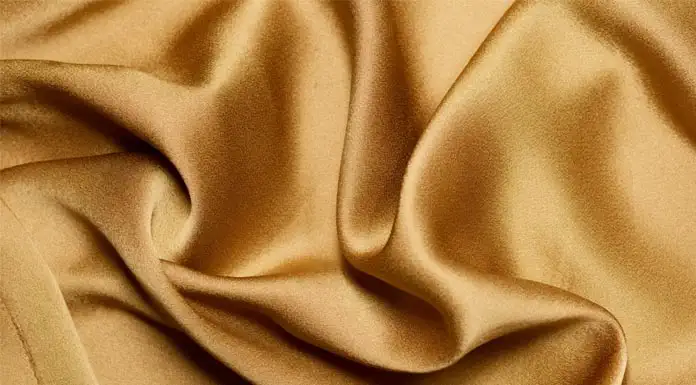In Assam, no marriage and festival is possible without silk. It is an intrinsic part of the culture of the people of this land.This age-old, indigenous Assam silk fabric has evolved from traditional mekhela-chador and eri shawl to fashionable items. It is made into exquisite saris, salwars,dresses, shirts, jackets, carpets and much more.
You may have used Assam Silk in your lifetime or waiting to buy one. There are many things to know a about Assam Silk before you buy silk sarees made from Assam Silk. To list, some are GI Tag of Assam Silk, Silk Heaven of India, Golden Silk, Durability, Luster of Assam Silk, etc.
I will list some interesting facts of Assam Silk. But, first, we will provide some basic knowledge of silk, history, types, process of making, uses, etc. of Assam Silk. Now let us dive into the post.
TABLE OF CONTENTS
SILK
Silk is natural fabric made up of protein. It has many inherent characteristics. To list, some of them are.
- Lusture,
- Softness,
- Elegance,
- Versatility,
- Wearability,
- Yarn strength, etc
Due to the above property, it is woven into textiles. Silk fiber is obtained from the cocoons produced by silkworm larvae
Chemical Composition of Silk(Silk Protein)
Fibroin and Sericin are two important proteins which silk is made of. Fibroin(C15H23N5O6) makes up 73.5% of silk and Sericin (C15H25N5O8) 22.28% of silk.
Since silk is a fibrous protein it is composed of a heavy chain, light Chain and glycoprotein linked by disulphide bond. Sericin acts as adhesive or gum to bond fibron for making cocoons.
Physical Properties of Silk
Silk is popular because of its unique physical properties. To list some are.
- It is the only fibre that can be woven into fabric in its raw state.
- A single yarn has high strength.
- It has high elongation.
- It is soft & Lustrous.
- High Hairiness Value -total length of all the hairs protruding from the silk yarn (in cm)
- Good Abrasion Resistance.
- High Area Shrinkage.
All the physical properties are available in Assam Silk and are of high quality.
Sericulture
Sericulture is the process of rearing silkworms to produce raw silk. It involves 3 steps. To list, they are.
- Growing Silkworm Foodplant.
- Silkworm Rearing.
- Reeling & Spinning of Raw Silk
Generally, I will discuss sericulture from two focus points- The rearing of Silkworm and Processing silk from cocoons.
Rearing of Silkworm

Female Silk moths lay eggs. Farmers of Assam Silk Industry buy these eggs fromAssam silkworm production centres (grainages). Then, these eggs are hatched under a clean enviroment with the required temperature and humidity. From the egg, silkworm larvae or caterpillar hatches.
These silkworm larvae feed on leaves of plants like mulberry, castor plant, oak, etc. The larvae eat these leaves and grow in size. Each variety of silkworm feed only on a particular leaves of plant.
After 30-40 days, the silkworm larvae stop eating leaves and start spinning cocoons around them. These cocoons are the main source of silk. Then, the silkworm develop into silk moth inside the cocoons.
Processing Silk from cocoons.
Sericin gums or stick together the silk fiber in cocoons. So, we need to degum the cocoon to get silk fiber. This process is called degumming. In this process, the cocoon is exposed to the sun or steamed or boiled.
Then, the silk fiber is unwinded from the cocoon. This process is called reeling. The silk fiber is then converted to silk threads to make different kinds of silk fabrics. Silk thread obtained from silkworm cocoons by reeling process is made into different types of silk fabrics.
History of Assam Silk
Assam Silk industry is the oldest and one of the largest industries in Assam. Not only this, it has become the home of the largest cluster of wavers and handlooms in India.
The history of Assam Silk dates back to the 3rd century BC. It is mentioned in the book- Arthashastra by Kautilya during Emperor Chandragupta Maurya. In there are high praises silk clothes from Assam. It describes the Assam Silk fiber as ‘the color of butter’, ‘as red as the sun’ and of supreme quality.
Historical records of Hiuen Tsang(7th century CE) and Banabhatta describe the silk route. It passes through China, Tibet and Burma to reach Assam. This silk route brought the knowledge of sericulture and the silk trade along with it. The knowledge of sericulture spread to Assam from China through this Silk route by 140 BC.
Muga Silk production received great patronage during the Ahom dynasty (1228-1826) of Assam. From this period only, culture thrived and became a part and parcel of Assamse culture.
Types of Assam Silk

There are four types of Silk in Assam. It falls into 2 broad categories.To list, they are.
- Mulberry Silk
- Pat or Mulberry Silk
- Non-Mulberry Silk
- Muga Silk or Golden Silk
- Eri or Endi Silk
- Tasar
Let us describe each one of them in detail.
Mulberry Silk
Mulberry silk is the most common silk in the world. It constitutes 90% of silk supply in the world. It is produced by a silkworm called bombyx mori. This silkworm only feeds on mulberry plant leaves.
Pat Silk or Mulberry Silk
Pat Silk of Assam is the most valuable and costliest silk in Assam. It occupies a major share in the silk industry of Assam. The pat silk is generally white in color. The white color ranges from brilliant white to off white.
In Assam it is generally called Nuni-Pat or Nuni. Because, the pat silkworm or mulberry silkworm feeds on Nunni (white mulberry plant) leaves.
To know more about Muga Silk, you can read this book titled “Muga Silk-The Golden SIlk of Assam”.
Non-Mulberry Silk
The silk obtained from silkworm larvae that fed on plants other than mulberry. There are 3 types of non-mulberry silk in Assam. This types of silk contribute to the total silk production of Assam
Muga Silk -The Golden Assam Silk.
Assam contributes to 95% of Muga Silk production in India. It is the most common type of silk used in Assam. The Muga silk is obtained from a semi-domesticated silkworm called Antheraea assamensis. These silkworms feed on aromatic leaves of two plants.
- Aromatic Som (Machilus bombycina)
- Sualu(Litsaea polyantha)
Muga silk is specific to Assam and an integral part of the tradition and culture of Assam. This silk is golden yellow in color with fine texture, lustre and durability. This silk usually used to make saris, mekhla and chadors.
Eri or Endi Silk
Eri is a type of silk found in Assam. It obtained from a domesticated silkworm, Philosamia ricini . It feeds on eri plant (castor plant). So, the silk from this variety of silkworm gets its name. Assam contributes to 65% of Muga Silk production in India
Eri Silk is also known as Ahimsa(Ahinsa) silk or fabric of peace. The cocoon of this type of silk is open mouthed. Because, the silkworm leaves the cocoon by itself.
Eri SIlk of Assam the most textured silk having properties of strongness, durability, elasticity and softness. It is darker and heavier than other silk. So, it blends with wool and cotton.
Eri silk is used to make warm clothes as well as summer clothes due to its unique thermal properties. It keeps warm in winter and cool in summer. Apart from the above properties, it is wrinkle-free and comfortable to wear.
Tasar Silk/Tussar SIlk
Tasar Silk is of two types- Tropical Tasar and Oak Tasar. This silkworm is reared in the wild. Oak Tasar is the finer variety among the two. In case of Assam, oak tasar is found.
Tasar silk in Assam is produced by a silkworm called Antheraea Proylei. It is cross breed between Antheraea Roylie and Antheraea Pernyi.Only two districts of Assam- Karbi Anglong and Dima Haso produce Tasar Silk in Assam.
Saree is the most important product of tasar silk. It is also used as base materials for handicraft, furnishing fabrics, stitched apparel, etc.
Uses of Assam Silk
Popularly silk known for ita use in textile industry. But, there are many unknown uses of it. Let us dicuss each one of them.
Garments
Silk sarees, traditional mekhela chadors, and ready made garments like shirts, suits, ties, blouses, pajamas, jackets etc is made from raw silk.
Bedroom Linen
There are many items made from silk used in bedroom furnishing. To list some are
- Silk Bedsheet
- Silk Pillow Cover
- Comforters
- Sleeping Bags, etc
Household Furnishing
Assam Silk is Luxury household furnishing. To list some are.
- Carpet
- Furnishing
- Curtain
- Draperies
- Cushion Covers
- Sofa Covers
- Wall hanging
Warm Clothes
Warm clothes are made from Silk mixed with cotton or woolen fabric. As already discussed above, Eri silk is mainly used to make warm clothes due its unique thermal properties. Shawls, Socks, and stockings is made from this silk, Knitted materials is also made from silk.
Medical Use
Silk gut is used in surgery for internal suturing i.e stitching internal organs. Silk fibroin vascular graft is used to replace abdominal venous systems.
Industrial Use
There are many industrial use of silk fiber. To list some of them are.
- Used to make Car tires to have a longer life span.
- Artillery Gun Powder Bags.
- Parachutes.
- Sound Free Gears for making precision machinery.
- Packing Material in the Pencil Industry.
- Making Talcum Powder.
- High end shampoos and conditioner
9 Interesting Facts About Silk of Assam

#1. Muga Silk- Golden Assam Silk
Assam is the largest and famous golden Muga Silk producer in the world. Muga Silk is endemic to Assam. It is associated with the culture and rituals of Assam. In Assam, no marriage and festival is possible without Muga silk. It is an intrinsic part of the culture of the people of this land.
Muga Silk production received great patronage during the Ahom dynasty (1228-1826) of Assam. From this period only, culture thrived and became a part and parcel of Assamse culture.
#2. Silk Heaven of India
Sualkuchi, a small village 32 kms away from Guwahati, Assam is known as the Silk Heaven of India or Manchester of Assam. Assam produces 21% of the total silk production of India. The Assam Silk Industry is concentrated in Sualkuchi.
The weavers and artisans of Sualkuchi produce muga silk and mulberry silk (pat) along with tasar silk. Most of the families in this area have handlooms called “taatxaal”. Sualkuchi Assam silk is the most sought silk from Assam.
#3. GI Tag of Assam Silk
Muga Silk of Assam obtained Geographical Identification (GI) Tag in 2007. It is the first item from Assam to get GI tags. You can see the details of the GI Tag here.
Moreover, Assam Muga Silk also was granted GI logo for trademark purposes in 2014. The logo has been registered with ASTEC (Assam Science Technology and Environment Council). You can see the logo from this link.
#4. Exporter of Silk
USA, UAE, UK, France, Italy and Germany are the main importer of Assam Silk and it products. The main export items are
Silk Yarn Ready Made Garments Silk Carpets Silk Waste
The USA is the major exporter of silk from Assam. The export of silk products from Assam stood at US$106 million in recent years. It was followed by the UK and UAE at US$ 22 million and US$19 million respectively.
#5.Increase in Luster after each wash
As we know, the durability of clothes we wear daily and shelf life of clothes decreases with every wash. The color fades away and the strength of fabric weakens with every wash. But, it is reverse in case of Assam Silk.
The luster or shine of Mulberry Silk(eri) increases after each wash. The warm clothes of tasar silk get warmer as it ages.
#6.Contribution of Assam Silk in India
Assam Silk contributes 21% of the total silk production of India. Moreover, Assam is the highest contributor of Muga Silk and Eri Silk production. It contributes 95% of total muga silk in India and that of Eri Silk it is 65% of total Eri SIlk production in India.
Infact, Assam is the largest producer of Muga Silk in the world.
| Type of Assam Silk | 2019-20 | 2018-19 |
| Pat/ Mulberry Silk | 68 MT | 68 MT |
| Muga | 198 MT | 191 MT |
| Tasar | 3 MT | 2.9 MT |
| Eri | 5042 MT | 4837 MT |
#7.Women
In Assam Silk Industry around 77% of the workforce is women. It is a women-friendly occupation. This industry involves women for silkworm rearing, reeling & spinning and weaving.
Assam Silk is run by women along with their domestic core. Infact, women in weaving are famous throughout India. In every household of Assam, especially in rural areas, there is a footloom or handloom for weaving. Whenever a woman of the family gets free time, she engages herself in weaving traditional clothes.
#8.Environment Friendly & Eco-Product
Assam silk plays an important role in environmental protection. The host plant of silkworm in Assam are evergreen and add to environmental sustainability and soil protection. The pupae of silkworm is utilised as food protein, fertilizer and fish feed.
Besides, silk is biodegradable in spite of being strong and highly durable. Moreover, Assam Silk is 100% hypoallergenic i.e it doesn’t cause any type of allergy. Moreover, Assam Silk is odorless and breathable fabric.
#9. Seed Farm of Assam Silk
Healthy Silkworm egg production is the primary need for a conducive growth of the entire silk industry of Assam. Moreover, timely supply of superior quality siik is must to sustain sericulture.
So, Assam Govt. provides healthy superior silkworm seeds from designated silkworm seed production centres.
These silkworm production centers are known as grainages. And silkworm seed from these grainages is known as Disease Free Layerings (DFLs). Both Government & Private Grainages are involved, due permission from Assam Government.
There are different Silkworm seed farms for each type of Assam Silk. The Names of Farms are listed below.
Mulberry Seed Farms
| Location of Farm | Name of District |
| Agia | Goalpara |
| Howly | Barpeta |
| Titabor | Jorhat |
| Gaurisagar | Sivasagar |
| Pailapool | Cachar |
| Kanduli, Denchowa | Nagaon |
| Rangati, Tarioni | Lakhimpur |
| Hilloibam- Dibrugarh | Dibrugarh |
| Mangaldoi- Darrang | Darrang |
| Sangbar- Dima Hasao | Dima Haso |
Muga Seed Farms
| Name of Farms | Name of District |
| Govt. Basic Muga Seed Farm, Khanapara, Guwahati | Kamrup Metro |
| Govt. Basic Muga Seed Farm, Narayanpur | Lakhimpur |
| Govt. Basic Muga Seed Farm, Kokrajhar | Kokrajhar |
| Muga P2 Station,Jalah | Baksa |
| Muga substation, Sarupathar | Golaghat |
| Muga Farm Hamren, Khorongma | Karbi Anglong |
| Langklam | Dima Haso |
Eri Seed Farms
| Name of Farms | Name of District |
| Borduar, Topatoli | Kamrup |
| Jamuguri | Sonitpur |
| Deomornoi | Darrang |
| Barbaha | Nagaon (Hojai), |
| Oujari | Morigaon |
| Demow | SIvasagar |
| Rangagarah | Golaghat (Bokakhat), |
| North Lakhimpur | Lakhimpur |
| Jonai | Dhemaji |
| Rangsali | Dibrugarh |
| Tingrai, Lakhimipathar | Tinsukia |
| Dharmikhal, Harinagar | Cachar |
| Adarkona | Karimganj |
| Dhenubhanga | Goalpara |
| Kokrajhar | Kokrajhar |
| Goreswar, Jalah | Baksa |
| Bhergaon | Udalguri |
| Dengaon, Dillaji, Umsoi | Karbi Anglong |
| Khejurband, Haflong | Dima Hasao |
Conclusion
To sum up, we have in detail discussed Assam Silk, its types and its uses. You might have got some brief knowledge about Assam Silk namely-Pat Silk, Eri Silk, Muga Silk and Tasar Silk.In the end we have discussed 9 interesting facts about Assam Silk.
